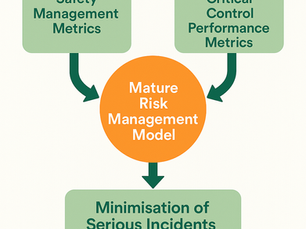top of page
Search


Critical Control Verification: How to Prove Your Most Important Safeguards Are Working
When people hear the term Critical Control Verification, they often assume it’s reserved for high-risk industries like mining or oil and gas. But here’s the truth: every business has critical controls and verifying them doesn’t have to be technical or time-consuming.
May 263 min read


Complacency in Workplace Safety: Why Comfort Is More Dangerous Than Crisis
In psychology, crisis triggers growth. It creates urgency, activates problem-solving, and mobilises resources. On the other hand, comfort breeds complacency. It convinces us that things are fine, even when critical risks are quietly stacking up behind the scenes. In a workplace setting, this psychological trap has serious implications for health, safety, and risk.
May 253 min read


Why Long Lists of Controls Aren't Effective
When reviewing a risk register or investigating an incident, it’s common to find a long list of risk controls associated with a single hazard. But a long list of controls does not mean the hazard is being effectively managed. In fact, many of those listed controls may do very little to prevent harm.
May 204 min read


What is a Risk Bowtie Analysis?
A Bowtie Risk Analysis is a simple but powerful tool that helps us visually map out the causal pathways that lead to an unwanted event and the escalation paths that can make things worse. And unlike traditional methods, the bowtie focuses on what matters most – the causes.
May 134 min read


Should a Critical Control Failure Trigger a HPI?
We know that incidents occur when controls fail. That’s the relationship we work with in every investigation. So, if a critical control failure is picked up in a CCV — even if there’s no injury, no damage, and no catastrophic event — shouldn't we treat that just as seriously?
Apr 134 min read


What is a Critical Control Performance Standard?
A Critical Control Performance Standard defines what “good” looks like for your most important controls. It outlines how the control should be implemented, who’s responsible, what training is needed, how to verify it, and what to do if it fails. Without it, even the best controls can quietly fall apart.
Apr 113 min read


Are Your Controls Too Complex for Workers to Understand?
What good is a control if the worker implementing it doesn’t understand it?
Apr 65 min read


Understanding Control Failure
In risk management, we spend so much time discussing whether controls are effective under normal conditions. But what if they fail?
Apr 33 min read


Velocity: Why Speed Matters in Risk Management
When people think about risk, they focus only on likelihood and consequence. But there's another critical factor that deserves attention: Ri
Apr 33 min read


Enhancing Administrative and PPE Controls with Engineered Reliability
When we think about the Hierarchy of Control, administrative controls and personal protective equipment (PPE) are often considered weak
Apr 34 min read


Why We Developed Investigative Risk Management — and Why Your Organisation Needs It
When was the last time your risk assessment process actually challenged assumptions, exposed system weaknesses, or strengthened controls
Mar 272 min read


Should you Appoint Risk and Control Owners?
One of the most effective strategies for managing risk is the appointment of dedicated Risk and Control Owners. But what does this involve, and is it the right approach for your organisation?
Jan 253 min read


Choosing the Right Safety, Risk, and Audit Support
For SMEs with no dedicated safety and risk personnel, SSRS ensures compliance, supports regulatory requirements
Jan 71 min read


Managing the Critical Risks of Hazardous Equipment: Protecting Workers and Preventing Disabling Injuries
Hazardous equipment presents some of the most significant risks across industries, often resulting in severe, life-altering injuries such as
Nov 28, 20248 min read


Bridging Risk Management and Incident Investigations: A Continuous Cycle of Improvement
In the dynamic landscape of workplace safety, risk management and incident investigations are often treated as separate processes
Nov 26, 20244 min read


Electrical Energy Critical Risk Management
Electrical energy is critical to modern industries but poses significant risks, including electrical shocks, burns, arc flashes, fires
Nov 23, 202410 min read


Confined Space Critical Risk Management
Working in confined spaces is one of the most hazardous activities across various industries. Confined spaces, such as tanks
Nov 19, 20249 min read


Why Regular Reviews Are Essential for Critical Risk Management
Regular reviews of critical risk programs ensure your organisation remains compliant, effective, and adaptive to changing circumstances
Nov 19, 20243 min read


Managing Critical Risks: Insights from Ten Years of Fatalities and Serious Incidents
This article explores key critical risks, highlights exposed industries, and examines trends in fatalities and serious incidents
Nov 19, 20243 min read


Working at Heights Critical Risk Management
Working at heights is one of the most critical risks faced across many industries. Whether it involves accessing rooftops, using EWPs
Nov 19, 202411 min read
bottom of page




